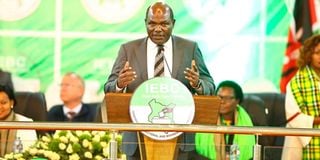Lengthy tallying process and why democracy calls for patience

Independent Electoral and Boundaries Commission (IEBC) Chairman Wafula Chebukati during a Press briefing at the Bomas of Kenya on August 10, 2022.
What you need to know:
- The elections are far from over because tallying of the presidential votes is far from complete.
- The law appoints the Independent Electoral and Boundaries Commission (IEBC) chairman as the returning officer for the presidential election.
- It also requires the returning officer to scrutinise both forms 34A and the constituency tally, contained in form 34B, and thereafter announce the results.
The anxiety is over for many seats where tallying is complete and results have been announced.
Celebrations are ongoing. For both winners and losers, well done. But the elections are far from over because tallying of the presidential votes is far from complete.
The country is waiting with bated breath. So, why does tallying take so long?
We vote for six seats. No news there. Earlier reforms ensured that once the polling station closes, it becomes a counting centre.
In our previous incarnation, ballot boxes would be transported to central counting centres. As you can imagine, many changes would take place on the way. But back to the present.
After counting, the results are recorded in Form 34A for the presidential contest and form 37A for the gubernatorial seat.
Both the presiding officer and the agents of the various candidates are expected to sign to certify the result. Where an agent refuses to sign, she must also indicate the reasons for the refusal.
This takes place on the night after voting, because the presidential votes are counted first. That is how most of the forms 34A were uploaded on the publicly available electoral agency’s portal this week.
The law appoints the Independent Electoral and Boundaries Commission (IEBC) chairman as the returning officer for the presidential election.
It also requires the returning officer to scrutinise both forms 34A and the constituency tally, contained in form 34B, and thereafter announce the results.
National tallying centre
The constituency returning officers then present the physical forms to the national tallying centre, in this instance at the Bomas of Kenya.
Obviously, since the returning officer also has to deal with the other five contests, it can take days to conclude them and travel to Bomas to present the physical documentation. This is presumably why there are deputies.
In a first in the region, and possibly further afield, the IEBC made forms 34As immediately available on its public portal.
This makes perfect sense since the results as declared at the polling (counting) station are final and cannot be changed without a legal process.
That means the results of the presidential election are already publicly known, if only on a provisional basis.
Provisional because only the IEBC chairperson can announce the official results after scrutinising the physical forms containing the results.
Once Forms 34A have been physically presented to the national tallying centre, the long and tedious verification process begins.
The forms are shared with the various agents of the presidential candidates, who also check the accuracy of the information.
They do so by counter-checking with the copies of forms obtained from the polling station and constituency agents.
This is to ensure that no changes are introduced in transit, as used to happen in years past.
In other democracies, media houses use publicly available information to “call” the election.
In the US, for example, the results are not “official” until they are certified by Congress, two to three months after the actual election. It seems democracy requires patience.
@NdirituMuriithi is the Governor of Laikipia County





